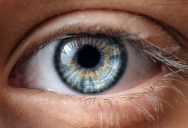Here’s Why Blue-Eyed People Are All Related And Why Blue Eyes Don’t Actually Exist At All

Sure, blue eyes are pretty.
But if you have them yourself, should you avoid dating or marrying someone else with the same pretty hue?
Well, you are all related…but also, blue eyes don’t really exist.
1 in 4 Americans have blue eyes, and 3 out of every 7 U.K. residents doo, too. It’s even more common in the Netherlands (3 of 5) and Iceland (3 of 4), but in nature, the color blue is actually not that common.

In fact, no mammal has naturally blue fur or hair – so do blue eyes even exist?
Technically, they don’t, says optometrist Gary Heiting.
“Blue eye color is determined by melanin, and melanin is actually brown by nature. Brown melanin is the only pigment that exists in the eye; there is no pigment for hazel or green – or blue. eyes only appear to be these colors because of the way light strikes the layers of the iris and reflects back toward the viewer.”
Like all of the other beautiful “blue” hues we take for granted, it’s mostly down to physics, explains author George Britton.
“In the animal kingdom there are many examples in which the observed color is the result of optical phenomena such as light scattering, interference or diffraction by microscopic structures present in the tissues. The most familiar example of this effect is the blue of the sky.”
While sunlight is in space the light is white (comprised of all the colors), but once it hits our atmosphere, things like dust and gas and other particles scatter the colors.

Blue is a smaller wavelength of light on the spectrum, which means it’s more likely to get caught bouncing around.
“Very small particles, smaller in diameter than the wavelength of red of yellow light, will reflect or scatter more of the short wave than of the long-wave components of white light. Colors produced in this way are known as structural colors.”
That said, there are two different effects that create the blue of the sky and the blue of your eyes (Rayleigh and Tyndall scattering), but the effect is the same.
“Most non-iridescent blue colors in animals are Tyndall blues. The blue color of human eyes is due to the scattering of white light by minute protein particles in the iris.”

Green and hazel eyes have slightly more melanin in the iris, so the light is absorbed slightly differently – and is why our eye color can shift or change based on the lighting.
“It’s an interaction between the amount of melanin and the architecture of the iris itself. It’s a very complex architecture.”
So your baby blues are just a trick of the light.
It doesn’t make them any less pretty, though.
If you found that story interesting, learn more about why people often wake up around 3 AM and keep doing it for life.

Sign up to get our BEST stories of the week straight to your inbox.




